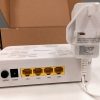Pilot to Connect 100 Rural Schools in England with Gigabit Broadband UPDATE
The UK Government has today announced the launch of a new £3m pilot project under their £190m Local Full Fibre Networks (LFFN) programme, which within the “next few months” aims to connect more than 100 primary schools in rural parts of England to a Gigabit capable FTTP broadband ISP network.
By the sounds of it the public funding is only being used to help cover the expensive civil engineering (network build) costs and we note that several ISPs – including Wessex Internet, Openreach (BT), KCOM, Fluidone, Updata, GTT and E2BN – have already confirmed plans for builds with different schools (schools invited to take part in the trial have to get quotes, but it’s open to any Gigabit capable providers).
So far 3 schools have already been connected and a further 52 have signed contracts with work due to be completed in the coming weeks (list at the bottom of this article). The project currently looks set to be “delivered under-budget” and thus more than 100 schools are ultimately expected to benefit by completion (currently there are said to be “ongoing discussions” with another 72 schools).
Advertisement
Naturally all of these deployments are focused on communities that are not currently in any commercial roll-out plans for a “full fibre” (Fibre-to-the-Premises) broadband network, which at present reflects most of England but the specific focus here is on rural areas (i.e. this is all reflective of the Government’s “outside-in” approach to deployment under the Future Telecoms Infrastructure Review).
The obvious benefit here is that the schools end up becoming ultrafast “broadband hubs,” which can in turn be used to spread Gigabit connection speeds out to rural homes and businesses in the surrounding areas, often at a lower cost. In fact that’s a key part of the new pilot but it’s too early to say precisely how many premises will actually benefit.
Margot James, UK Minister for Digital, said:
“This project is a great example of the Government’s new “outside in” approach to rolling out full fibre broadband, which is taking gigabit broadband to the hardest to reach rural areas first.
As well as making a dramatic difference for students in the classroom, by using the schools as broadband hubs we are also making ultrafast broadband available to thousands of rural homes and businesses across the country more quickly.”
Kim Mears, MD for Openreach’s Strategic Infrastructure, said:
“We’re really pleased to be able to support the Government’s drive to connect up schools with full fibre broadband through our Full Fibre Infrastructure Build programme, which enables schools not in our commercial roll out plans to still connect to our full fibre network – without incurring any build costs.
Without fast reliable connectivity there is the risk that children will miss out on what is now an essential learning tool, so being able to connect up schools in this way is great news.”
Apparently the schools that have already connected under this pilot are understood to have seen their broadband speeds leap from 0.5Mbps to 100Mbps, although as per the headline these connections must have the capability to be upgraded to 1000Mbps (1Gbps) in the future “should they wish to do so.”
In any case for smaller primary schools 100Mbps is often enough to enable whole classes to simultaneously surf the internet on tablets as part of structured lessons, as well as supporting other online training, cloud services and educational learning tools. This can even help to save money as schools may be able to decommission some of their local servers to reduce hardware, maintenance and IT support costs.
Advertisement
Interestingly the Government said that today’s pilot will be “instrumental” in shaping how they invest the next £200m pot of funding under the existing LFFN Challenge Fund, which readers may recall was announced as part of last year’s Budget 2018 (here); this is in addition to the existing £190m pot.
Just to recap, the budget set aside £200m to “pilot innovative approaches to deploying full fibre internet in rural locations, starting with primary schools, and with a voucher scheme for homes and businesses nearby. The first wave of this will include the Borderlands, Cornwall, and the Welsh Valleys.”
You can see how the above quote echoes today’s announcement. However it remains to be seen whether the “voucher” scheme mentioned above will be something new or an extension of their existing Gigabit Vouchers (details).
List of schools connected already or due to be connected shortly
Dorset
Cheselbourne PrimaryDerbyshire
Peak Forest PrimaryDevon
Cheriton Fitzpaine Primary School, Highampton Community Primary School, Princetown Community Primary School, Holbeton School, Farway Church of England Primary, Filleigh Community Primary School, St Joseph’s Catholic Primary SchoolGloucestershire
Hartpury Church of England Primary, Slimbridge Primary School, Northleach Church of England Primary School, Churchdown Parton Manor Infant School, Churchdown Parton Manor Junior SchoolKent
St John’s Primary, Blean Primary School, St John’s CE Primary SchoolLincolnshire
Horblings Browns, Wrangle Primary School, The Hackthorn Church of England Primary School, Fleet Wood Lane Primary, Fairfield Infant and Nursery School, Quadring Cowley, Dunston St Peters School, Langtoft Primary School, Louth Kidgate Primary Academy, The Hackthorn Church of England Primary School, Whaplode Primary, Sturton by Stow Primary School, Nocton Primary School, Digby CofE Primary School, St Joseph’s Catholic Primary School, Bucknall Primary School, Legsby Primary SchoolSomerset
Banwell Primary School, East Anstey Primary SchoolWiltshire
Wardour Catholic Primary School, Lacock Church of England Primary SchoolCambridgeshire
Wittering Primary SchoolDerbyshire
Wigley, All Saints CofE Junior School, Osmaston CofE (VC) Primary School, Stoney Middleton CofE (C) Primary School, Stretton Handley Church of England Primary School, Brailsford CofE Primary School, Peak Dale Primary School, Thornsett Primary School, Pilsley CofE Primary School, Parwich Primary School, Kilburn Junior School, Duke of Norfolk CofE Primary School, Saint Mary’s Catholic Primary, Hady Primary School, Westhouses Primary School, Eureka Primary School, Stanton Primary SchoolEast Sussex
St. Peter’s CE Primary School, St. Michael’s CE Primary School (Playden), Stonegate CE Primary SchoolHerefordshire
Bromesberrow St Mary’s Church of England (Aided) Primary SchoolNorthamptonshire
Old StratfordWest Sussex
Wivelsfield Primary School
UPDATE 28th Feb 2019
Advertisement
One of the suppliers in the schools project, RM Education, has kindly furnished us with a comment.
John Srawley, Head of Connectivity for RM Education, said:
“RM Education welcomes this announcement by the DofE and DCMS – as a leading provider of connectivity to schools across the UK, we have been engaged in the pilot phase of the Local Full Fibre Networks Programme from the start. The LLFN programme is great news for schools across the UK in remote locations, unlikely to be prioritised on commercial fibre build out plans.
Our strong presence in the South West of the UK made RM Education an obvious choice in discussing the programme and supporting more than 25 qualifying schools with the improved service that the programme offers.”
Mark is a professional technology writer, IT consultant and computer engineer from Dorset (England), he also founded ISPreview in 1999 and enjoys analysing the latest telecoms and broadband developments. Find me on X (Twitter), Mastodon, Facebook, BlueSky, Threads.net and Linkedin.
« UK Named One of the Cheapest EU Countries for Mobile Broadband
















































Comments are closed